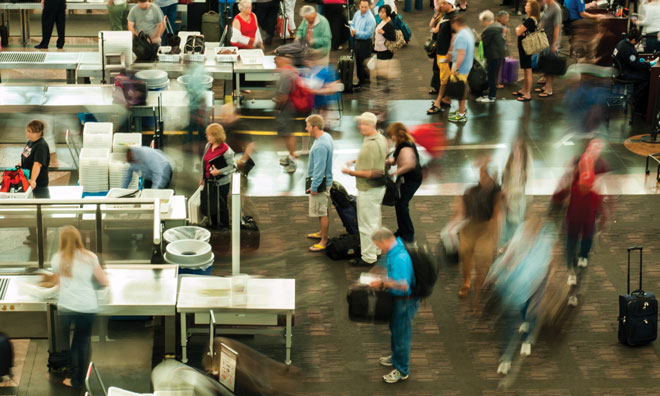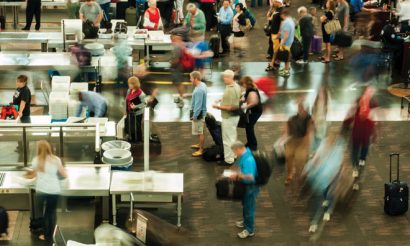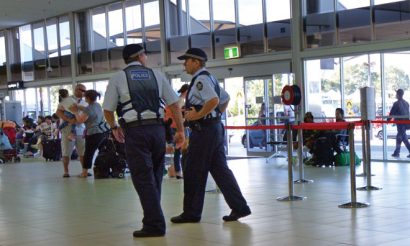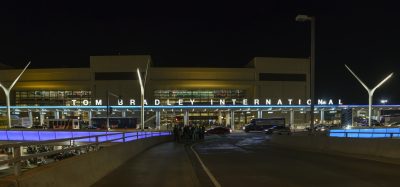The Security Series: Securing the public side of airports
- Like
- Digg
- Del
- Tumblr
- VKontakte
- Buffer
- Love This
- Odnoklassniki
- Meneame
- Blogger
- Amazon
- Yahoo Mail
- Gmail
- AOL
- Newsvine
- HackerNews
- Evernote
- MySpace
- Mail.ru
- Viadeo
- Line
- Comments
- Yummly
- SMS
- Viber
- Telegram
- Subscribe
- Skype
- Facebook Messenger
- Kakao
- LiveJournal
- Yammer
- Edgar
- Fintel
- Mix
- Instapaper
- Copy Link
Posted: 1 December 2016 | James Braver, U.S. Director for the TIX Group; Peter DiDomenica, President of Quantum Innovation Corporation | 1 comment
Welcome to ‘The Security Series’ from International Airport Review, featuring an extensive insight into matters of aviation and airport security with interviews and opinion pieces from key industry leaders and experts…


In this article, James Braver of TIX Group and Peter DiDomenica of Quantum Innovation Corp. discuss how airports can secure their vulnerable public side….
In light of the recent terrorist suicide bombing attacks at Zaventem International Airport, Belgium in March 2016 and Istanbul Ataturk International Airport, Turkey in June 2016 it has become evident that international terror groups have shifted the focus of terror attacks on commercial aviation from the aircraft to the airport terminals.
History of terrorism directed at commercial aviation
The first terror attack specifically targeting commercial aviation is generally thought to have been the July 1968 hijacking of El Al Flight 426 from Rome to Tel Aviv by members of the Popular Front for the Liberation of Palestine. Prior to this event, hijackings were principally used as a means to escape a country or for ransom. The number of hijackings taking place peaked in the late 1960s and early 1970s with 151 hijackings or attempted hijackings between 1968 and 1970. Since the 1970s hijackings have steadily declined, largely due to enhanced passenger screening procedures and technology.


The terrorist tactic of using explosives to down airliners started with the explosion of a bomb concealed in luggage on Pan Am Flight 103 over Lockerbie, Scotland on 21 December 1988, which killed all 270 people on board. This tactic became a frequent means of attack – starting shortly after the 9/11 attacks on the Twin Towers in New York – with the December 2001 failed attempt to down American Airlines Flight 63 from Paris to Miami by Richard Reid using explosives concealed in his footwear.
Terrorist attacks against airports began with the 1972 attack of Lod Airport in Israel by the terror group Japanese Red Army, in which 26 were killed and 80 injured. This launched a decade of 39 terror attacks against airports from 1973 to 1982. There were three major attacks on airports in 1985 at Rome’s Leonardo da Vinci-Fiumicino Airport, Vienna’s Schwechat Airport, and Tokyo’s Narita International Airport followed by relative quiet until the bombings of Madrid-Barajas Airport in 2006 and Glasgow International Airport in 2007.
The desirability of terrorist attacks against commercial aviation
Commercial aviation is one of the most, if not the most, desirable of targets for international terror groups such as Al Qaeda. One need only consider the enormity of the 9/11 attacks or attempts such as the failed 1995 ‘Bojinka plot’ to see actual and potential catastrophic results of such attacks, which is precisely what terrorist groups seek.
In addition to the catastrophic nature of these attacks, there are several other reasons for the targeting of commercial aviation. In addition to maximum loss of life, terror groups have three other principle objectives: to gain maximum media coverage, which thereby maximises the infliction of fear and panic in the targeted populations; to attack an important symbol of the enemy; and to inflict the maximum economic damage to a nation, which terrorist groups have found to be the most effective way to get a nation to change its policy. The targeting of commercial aviation serves to advance these objectives in several ways.
“Media coverage of terror attacks against commercial aviation is intense and dominating…”
Partly due to the effect on our collective memories of 9/11, media coverage of terror attacks against commercial aviation, or even the threat of an attack, is intense and dominating. Likewise, our collective memories of 9/11 tend to increase the sense of fear experienced when commercial aviation is attacked. Up to 30% of people are already apprehensive about flying under normal conditions so it doesn’t take much of a threat to keep people away from airports, which can have negative economic consequences. Attacks on airliners and airports, particularly international flights and terminals, enables terror groups to inflict the effects of their terror attacks on numerous nations and increase international attention to their cause. And, finally, there is a symbolic importance associated with commercial aviation as airlines are perceived to be extensions of national power and prestige.
How can airports increase protection for their public spaces?
‘Soft targets’ such as airport terminals, stadiums, shopping centres, casinos, and theme parks have become potentially ‘high-value, low-profile targets’. Any place where large crowds congregate with open public access is vulnerable.
Failure to take reasonable precautions may result in civil liability, with damages for such suits costing tens of millions of dollars. Although the expense of security improvement might be considered unnecessary and cutting into profits, there is a potentially much higher price if reasonable measures are not taken.
There are many approaches that can be adopted to help airport operators be better prepared to prevent an attack and minimise the damage of an attack, such as perimeter vehicle inspections; increased CCTV coverage and monitoring; greater police patrols; more K-9 sweeps for explosives; strategic placement of bollards or planters to prevent vehicle incursions; and use of facial recognition software. While these type of strategies must be considered and implemented when feasible, the single most cost effective method however is training police, security, and all front-line airport and airline employees in behaviour detection of hostile intent.


The first major terrorist attacks against commercial aviation were directed against Israel, as noted above. After the 1968 hijacking of El Al Flight 326, there has not been a single successful hijacking against Israeli commercial airlines. Similarly, after the 1972 attack of Lod Airport in Israel, there has not a single successful attack of an Israeli commercial airport. Israel’s airport security is viewed uniformly as the best in the world and one of the main contributing factors to their success is the use of behaviour detection trained employees throughout the airport.
Behaviour detection programmes in the United States
Following 9/11, the Massachusetts State Police at Boston Logan International Airport sought to incorporate Israel’s behaviour detection concept at the airport. In attempting to implement such a programme they discovered two major impediments. First, as performed in Israel, a person’s nationality, ethnicity or religion is used as a factor in determining the level of risk. Under the laws of North American countries, the European Union, and many other nations, disparate treatment based on such factors is unlawful. The second factor is scalability. Israeli airports and airlines devote substantial manpower and resources to behaviour detection. Virtually every passenger is interviewed and interviews can last up to an hour. In an airport system in the United States that has 45 times the volume of passengers (900,000,000 versus 20,000,000) such level of attention to passengers would cause the system to grind to a halt. Moreover, Israel spends 10 times more per passenger on security than the United States does. To increase spending per passenger for security in the United States to levels equal to Israel would amount to an additional $62.2 billion in spending.
The Massachusetts State Police created their own behaviour detection programme called Behaviour Assessment Screening System (BASS) in 2002, which explicitly forbade use of race, ethnicity, nationality, or religion as a factor of suspicion and trained officers on the effects of unconscious bias that can result in discrimination. The programme also sought out the latest scientific research on deception and non-verbal communication in order that any interviews would be structured to be customer-oriented and last an average of 90 seconds. Based on the success of the Massachusetts State Police BASS programme, the U.S. Transportation Security Administration (TSA) adopted it for their screening programme under the Screening of Passengers by Observation Techniques (SPOT). SPOT employs 2,800 TSA Behaviour Detection Officers deployed at every major commercial airport in the United States. The programme was also adopted by the British Transport Police in 2006 for its nationwide rail system.
Deploying a force multiplier
Behaviour detection techniques are a ‘force multiplier’, enabling staff to detect threats without high costs or slowing throughput, and with minimal customer awareness. By training airport and airline security, police, and front-line employees in behaviour detection, the airport gains an army of observers. Their training includes detection of pre-attack planning and surveillance activity in the days, weeks, and months before a planned attack and detecting an attacker farther away from critical densely populated areas of the terminals. This programme does not involve hiring additional staff, nor the purchase of expensive equipment and is therefore highly cost effective.
Since approximately 95% of patrons are merely observed – and, for those interviewed the process lasts generally no longer than two minutes – there is no measureable effect on throughput and the process largely goes unnoticed by patrons.
In a validation study of the SPOT programme by the U.S. Department of Homeland Security using proxy measures of prohibited items and arrests, about 70,000 random searches were compared to around 20,000 searches based on SPOT. The study found that the discovery of prohibited items increased nine times (900%) and the arrest rate increased 50 times (5,000%) for searches conducted based on SPOT suspicion indicators of the passenger.
In general, behaviour detection programmes rely upon a system using situational and behavioural baselines that are time and location specific and, where appropriate, through brief non-confrontational conversations with a small percentage of patrons. If the suspicion is not resolved, the passenger may be subjected to a higher level of screening, or, in exceptional cases, the airport police are called to investigate.
The authors, through the collaboration of leading security experts in the United States and Israel, have created behaviour detection systems that combine the best both countries have to offer with a special emphasis on meeting the legal, cost, resource, and throughput requirements of airports worldwide.
By taking advantage of all front-line employees’ abilities to observe and analyse their environment for signs of danger, airports can enlist an army of security associates actively engaged in protecting the airport. This critical additional layer of security for the public spaces of the airport can be acquired for minimal cost and with minimal effect on airport operations.
Biographies
James Braver is U.S. Director for the TIX Group, an Israeli security consulting group composed of former high-level officials from Israel’s security community. TIX Group’s leader is Assaf Heffetz, former Commissioner of the Israel National Police. James is responsible for coordinating all TIX activities in the U.S. and abroad and was responsible for launching TIX Group’s School Security Program in California. He has been a guest speaker for ASIS New England and the Hospitality Design EXPO in Las Vegas on the subject of the security aspects of hotel design.
Find out more at: www.thetixgroup.com
Peter DiDomenica is President of Quantum Innovation Corporation and is a retired Massachusetts State Police Lieutenant. He served as the Director of Security Policy for Boston Logan International Airport in the two years after 9/11 and designed the TSA behaviour detection programme, SPOT.
Find out more at: http://www.quantuminnovationcorp.com/
The Security Series
Exclusive interview with Angela Gittens, Director General of ACI World
Exclusive interview with Henrik Hololei, European Commission
Andy Blackwell: Staying one step ahead of civil aviation threats
James Braver; Peter DiDomenica: Securing the public side of airports
Solomon Wong; Karen Warnick-Elinan, InterVISTAS: Key trends in border preclearance
Exclusive interview with Ken Thomas Head of the Network Operations Coordination Unit at EUROCONTROL


















Hi James and Peter
Thank you for sharing this, as one who was trained and a practitioner of BASS I agree with you. My work in the UK at an International Airport included much of what you have high lighted together with other tactics and more so now with InterPortPolice. It requires key partnership working and support from top management which sometimes is where the difficulty can lay. However, as you say, it is a small investment, which adds value to the security of any crowded environment.